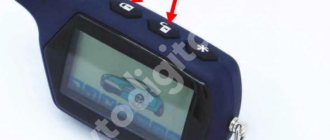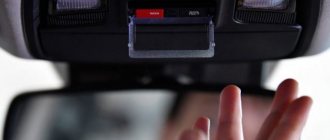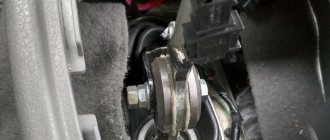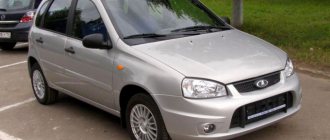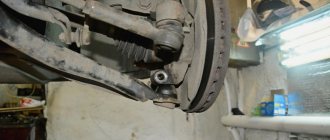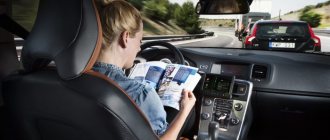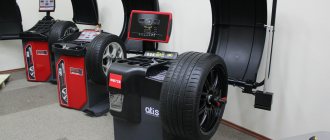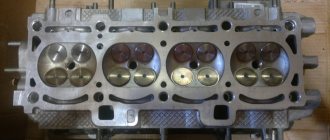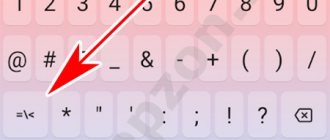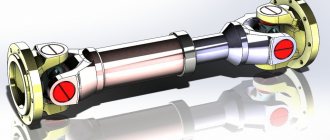Any PC/AT computer keyboard has special keys in English and means something. The arrangement of buttons on it follows a single scheme, each one is necessary for something. There are more than 100 of them. One of them is “Escape” (Esc), which plays an important role in the functioning of the keyboard. Without it, it is impossible to imagine the full use of a computer.
What does the Microsoft Word Shift TAB button combination do?
TAB
or
SHIFT
+
TAB
- Moves the focus of each command on the “ribbon” forward or backward, respectively. DOWN ARROW, UP ARROW, LEFT ARROW, or RIGHT ARROW - Move down, up, left, or right between items on the ribbon.
Interesting materials:
How to preserve peony rhizomes until spring? How to preserve a chrysanthemum bush until spring? How to preserve bush chrysanthemum in winter? How to preserve lilies for the winter without digging them up? How to preserve gladioli bulbs? How to preserve low-growing chrysanthemums? How to maintain soil fertility? How to store a purchased chrysanthemum in a pot? How to preserve chrysanthemum seedlings until spring? How to save gladioli seeds in winter?
History of appearance and why it is called that
Esc is an abbreviation of the English word “Escape” (escape, exit). This key is used to return to the previous state or exit in applications, games and programs. It is located in the upper left corner of the keyboard. This button has been present on desktop keyboards almost from the very beginning. The key was originally used in terminals. By the release of the first mass-produced computer, it began to be used to deselect, exit the selected mode, and also as an antagonist to the Enter button.
Modern users pay little attention to this key, preferring to cancel operations using mouse clicks. If you start actively using Esc when working with a PC, you can speed up the execution of many procedures and increase the comfort of using the device.
Hotkeys using Escape
The functionality of the button expands significantly if you use it in combination with other keys. Hot combination is the simultaneous pressing of 2 or 3 buttons on the keyboard. Among the combinations that can be used on a PC running Windows are:
- CTRL+SHIFT+ Esc (opens task manager);
- ALT+ Esc (quick transition between open windows);
- CTRL+ Esc (quickly open the start menu).
The task manager is used to view running processes and assess the load on system resources. It can also be used to close processes that have stopped responding or are not working correctly. The key combination Escape, Control and Shift will open the task manager and take the necessary actions to solve the problem.
A quick simultaneous click on the Alt and Escape buttons allows you to change tabs while moving between open windows. The transition is completed in less than a second. The Control+Escape combination is rarely used, since to perform it you can simply click on a separate Windows button.
Notes
Category:
- Keyboard
Wikimedia Foundation. 2010.
See what “Esc (key)” is in other dictionaries:
- ESC (meanings) - ESC is a three-letter abbreviation for: Electronic Stability Control (in a car) Electronic Cruise Control (in a radio-controlled model) European Shooting Sports Confederation Eden Synthetic Corps music group Others ... ... Wikipedia
- Shortcut key - Key combination (synonyms: hot key, quick access key, shortcut key, keyboard accelerator) (English keyboard shortcut, quick key, access key, hot key) pressing one or more keys on the keyboard to perform ... ... Wikipedia
- Control key - Ctrl button Ctrl (short for Control, pronounced /kənˈtrοl/) is a system button (key) on a computer keyboard. On modern x86 keyboards, "PC" is located in the lower left and right corners of the alphanumeric block. On computers... ...Wikipedia
- Ctrl key - Ctrl button Ctrl (short for Control, pronounced /kənˈtrοl/) is a system button (key) on a computer keyboard. On modern x86 keyboards, "PC" is located in the lower left and right corners of the alphanumeric block. On computers... ... Wikipedia
- Control key - Ctrl button Ctrl (short for Control, pronounced /kənˈtrοl/) is a system button (key) on a computer keyboard. On modern x86 keyboards, "PC" is located in the lower left and right corners of the alphanumeric block. On computers... ... Wikipedia
- Control key - Ctrl button Ctrl (short for Control, pronounced /kənˈtrοl/) is a system button (key) on a computer keyboard. On modern x86 keyboards, "PC" is located in the lower left and right corners of the alphanumeric block. On computers... ... Wikipedia
- "Ctrl" key - Ctrl button Ctrl (short for Control, pronounced /kənˈtrοl/) is a system button (key) on a computer keyboard. On modern x86 keyboards, "PC" is located in the lower left and right corners of the alphanumeric block. On computers... ...Wikipedia
- Control key - Ctrl button Ctrl (short for Control, pronounced /kənˈtrοl/) is a system button (key) on a computer keyboard. On modern x86 keyboards, "PC" is located in the lower left and right corners of the alphanumeric block. On computers... ... Wikipedia
- Backspace (key) - Backspace key (English Backspace return, literally “space back”) a key on a computer keyboard that serves to delete the character (characters) located behind the cursor (to the left of it when writing “from left to right”, and vice versa ). Outside... ... Wikipedia
- Break (key) - Pause/Break key on the keyboard Pause/Break key (English pause “to pause” and English break “to interrupt”) a key designed to interrupt the current process. On... Wikipedia
Hi all! Let me in this short note tell you about the Escape or Esc button. It has been on the keyboard for a long time, although few people seem to use it... and for good reason - it’s not that convenient...
In general, the inscription Esc is an abbreviation for Escape, the word is translated as run, run away. The button was present on the first keyboards; it was invented to create a hardware call to the function of canceling the execution of the last command, activating the Back action.
| Esc | F1 | F2 | F3 | F4 | F5 | F6 | F7 | F8 | F9 | F10 | F11 | F12 | PrtScSysRq |
| Ins | Home | PgUp | NumLk | / | * | − | |||||||
| Del | End | PgDn | 7 | 8 | 9 | + | |||||||
| 4 | 5 | 6 | |||||||||||
| ↑ | 1 | 2 | 3 | Ent | |||||||||
| ← | ↓ | → | , |
Keyboard location
It’s always in the upper left corner.. I found a cool picture, here are other buttons marked:
By the way, there was such a joke... it just irritates me unrealistically... there is a block of buttons on the keyboard above the arrows, you know? And there, on my old keyboard... there was a button to turn off the PC! It was terrible when I accidentally pressed it! And this happened when I was playing.. and just bam - all programs shut down, the PC turns off.. if you knew how much this infuriated me..
In general, I personally never use this Esc key. Because her behavior is unpredictable for me. There is one situation when I used it - when I needed to close the window of a program that... I created myself, there was time - I programmed it shorter
And so, in general, its use today is already a thing of the past. It’s better not to touch it, otherwise it will close a window somewhere... somewhere it will delete the text... and somewhere else it will do something, you’ll never guess what exactly...
Functional
- Exits an open application and then returns to the desktop.
- Minimize an open application.
- Cancels the operation currently in progress.
- Access folders and lists that are higher up in the hierarchy.
- Undo the last character entered in Word Excel.
- Undoes the last change made.
- Cancel selection.
conclusions
The Escape key helps simplify your computer work when surfing the Internet and using applications. When working with the command line, pop-up windows and text documents, Esc is an indispensable button. Some commands can only be executed by pressing this key (pausing games, exiting full screen mode in applications).
People who work on a PC for long periods of time every day are advised to learn shortcuts with various function buttons in order to use the computer at maximum efficiency. Advanced users, thanks to their knowledge, work more efficiently and quickly even in the simplest programs.
Operating principle of ESP.
Where is the license plate on the keyboard?
The main purpose of the device is to help in difficult situations and control the lateral dynamics of the car. In other words, maintain directional stability and trajectory, help stabilize the car during various maneuvers when driving on poor road surfaces and at high speeds. In general, ESP prevents the car from sliding sideways and the possibility of skidding.
ESP directly interacts with the engine control unit, traction control and ABS system. Without all this, it will be absolutely useless. The system is constantly in working condition, whether the car accelerates or reduces speed. The device has its own electronic control unit, which reads signals from all sensors, and if anything happens, it quickly makes the necessary decision, if required.
The necessary information comes from the lateral acceleration sensor (G-sensor) and the angular velocity sensor relative to the vertical axis. They are the ones who monitor the intensity of lateral slip and send a signal to the ESP unit, if necessary. Also, additional information is collected by ABS, brake pressure and steering wheel sensors. The device constantly monitors speed, engine speed, and steering wheel rotation. And if a skid occurs, it is ready to immediately react to it.
When skidding signals begin to arrive at the ESP control unit, the device begins to compare the current behavior of the car with the desired one, and if it finds deviations, it will immediately begin to act. In order for the car to return to the correct trajectory, the exchange rate stability system begins to brake the necessary wheels. Which ones, she determines herself. Braking occurs with the help of ABS, which builds up pressure in the brake system. At this time, the engine sends information to reduce torque and fuel supply.
A clear example of how the ESP system works.
The ESP system is constantly in operation: during acceleration, driving, braking. But the algorithm of actions depends on each individual case. For example, if the sensor detects the beginning of the rear axle skidding when turning, then a command is immediately given to reduce the fuel supply. If this does not help, then ABS begins to brake the wheels.
If your car is equipped with an electronically controlled automatic transmission, then ESP can also control the operation of the transmission: switch to low modes, or, if possible, to “winter mode”. This is actually the whole operating principle of this system.
Problem solving
Numbers are printed in words. On some mini keyboards (like laptops), this happens when the Num Lock key is pressed. Just click on it once.
The digital part doesn't work. And this happens on regular keyboards. This means the digital part is turned off. To turn it on, press Num Lock once.
The new text is printed over the old one. This happens if the Insert button was accidentally pressed. When you click on it, new text is printed, erasing the old one. To cancel this, you need to click on Insert again.
All letters are typed in capitals. Press Caps Lock.
There are no Russian letters on the keys. This usually occurs on laptops imported from other countries. The simplest solution is to buy stickers for the keys. They are sold in stores with various computer accessories (mice, flash drives, etc.) and are inexpensive.
The second more expensive option is laser engraving. You can apply any layout, not only Russian.
And the third option is to buy a new keyboard. Just buy a separate keyboard and connect it to your laptop.
Some keys don't work. The reasons for this may be different:
- Garbage. There are many articles on the Internet about cleaning your keyboard. The easiest way is to turn it over, shake it a little and go over it with a small brush or paint brush. You can also do a deep cleaning: remove all the keys and clean each one. But this must be done very carefully - there is a risk of not being able to collect it later.
- Laptop overheating. From time to time, the laptop needs to be serviced: clean the internal elements from dust, change the thermal paste, lubricate the fans. A computer technician can do this in a couple of hours. It’s easy to determine whether cleaning is needed: the computer makes noise, gets hot, works worse (slows down, freezes). With active use, you need to clean it once a year.
- Liquid ingress. If the keyboard is separate, then often it is enough to simply unplug it and dry it. It’s worse with a laptop – it may stop working altogether. It is better to immediately take it to the master.
Additionally, the keys may not function well because they have reached the end of their lifespan. This happens, for example, on old laptops.
Each button is designed for a certain number of clicks: inexpensive membrane ones - 5 million, scissor buttons (on laptops) - 10 million, expensive mechanical ones - up to 50 million.
In this case, you can buy a new keyboard. This also applies to laptops: you just connect it and work on it instead of the old one. You can also use the on-screen keyboard that I talked about.
As for the laptop, you can take it to the service center. The technician will disassemble the computer and give an opinion. If the keys do not work because the service life has expired, the keyboard can be replaced. But, most likely, it will not be very cheap - it’s easier to buy a regular separate one (for example, wireless).
What functions does the button perform?
Pressing Esc allows you to perform many operations. The specific action depends on which application is running. Among the main functions of the Esc key are:
- closing the dialog, search bar and other pop-up elements;
- Exit full screen mode when viewing photos or using a browser;
- canceling an ongoing operation;
- cancel selection.
In computer games, the button is often used to pause the gameplay and go to the settings menu. Escape is often used when working with documents to deselect text and return from the settings menu.
Program and application developers can give the key their own unique capabilities. However, in most cases, Esc is used precisely as a cancel key. To find out how the button works in various programs, you should study the information in the utility help.
Application
In Canada, the USA and the countries of the European Union, since 2011, stability control systems have been mandatory installed on all passenger cars. Note that system names vary depending on the manufacturer. The abbreviation ESC is used on Kia, Hyundai, Honda cars; ESP (Electronic Stability Program) - on many cars in Europe and the USA; VSC (Vehicle Stability Control) on Toyota cars; DSC (Dynamic Stability Control) system on Land Rover, BMW, Jaguar cars.
The dynamic stabilization system is an excellent assistant on the road, especially for inexperienced drivers. Do not forget that the possibilities of electronics are also not limitless. The system in many cases significantly reduces the likelihood of an accident, but the driver should never let down his guard.
Notes
- ↑ Figurnov V.E.
Chapter 1: devices included in the IBM PC // IBM PC for the user. - 2nd ed. - M.: Finance and Statistics, Unity, 1992. - P. 21. - 288 p. — ISBN 5-279-00900-8. - ↑ Norton P.
Chapter 10: Keyboard block // Hardware and software organization of the IBM PC computer = Inside the IBM PC. Access to advanced features and programming. - Prentice-Hall Publishing Comp., 1984. - ↑ Xah Lee.
History of Emacs & vi Keys (Keyboard Influence on Keybinding Design)
(unspecified)
.
| Computer keyboard service keys |
| Dead keys |
This page was last edited on July 18, 2022 at 1:22 pm.
Origin
The name of the equivalent key on some early Teletype Model 33 keyboards was labeled Alternate Mode
..., an alternative mode of operation in which the trigger mechanism processes the next character in a special way. Much later printers and computer terminals would use escape sequences, often taking more than one next byte as part of a special sequence.
The VT05 CRT does not have an ESC key; then the VT50, which appeared 4 years later.[1]
Directional stability: the whole car is under control
Well, now let's delve into the principle of operation and design of the exchange rate stability system. It belongs to high-level technologies, which means that other systems and components of the car are under its control. The key elements of VSC are:
- a set of various sensors;
- electronic control unit;
- actuators.
The condition of the car is monitored by a scattering of various sensors, namely: a steering angle sensor, pressure in the brake line, longitudinal and lateral acceleration of the body, wheel speed and angular speed of the car.
Based on the information received, the control unit assesses the situation in a split second, and if, in its opinion, the car is not moving as the driver wishes, it sends signals to the actuators to correct the situation. Devices that can be controlled by VSC electronics include:
- anti-lock brake valves integrated into the brake line;
- traction control elements;
- engine control unit;
- automatic transmission electronics (if, of course, the car has one);
- active wheel steering (also if equipped).
The consequence of the operation of the exchange rate stability system can be braking of the wheels, a change in the operating mode of the engine and gearbox, redistribution of torque along the axles or wheels, and so on.
